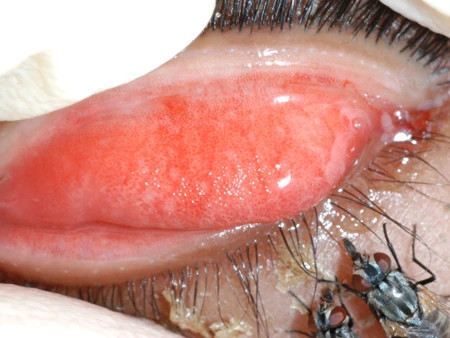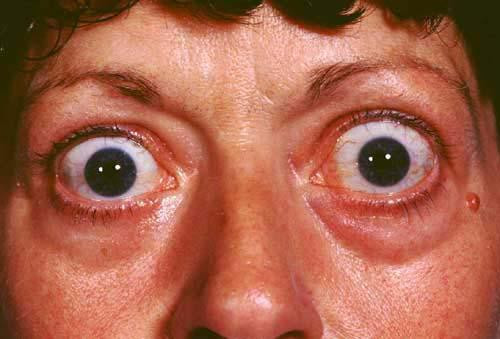Definisi
Ulkus kornea adalah luka terbuka pada kornea yang memberikan tanda berupa bintik atau area berwarna putih. Kondisi ini dapat mengganggu penglihatan dan bahkan menyebabkan kebutaan jika tidak ditangani dengan baik. Hal ini dikarenakan kornea merupakan satu-satunya jalan lewatnya cahaya untuk melihat. Sehingga, bila terjadi kerusakan pada kornea akan menyebabkan gangguan penglihatan sampai kebutaan.
Di Indonesia, angka kejadian ulkus kornea belum diketahui secara pasti. Namun, insidensinya diketahui lebih tinggi di negara berkembang dan kawasan padat penduduk. Di India, misalnya, kejadian ulkus kornea mencapai 113 per 100.000 penduduk per tahun. Angka ini kurang lebih 10 kali lipat dibandingkan kejadian di Amerika Serikat.
Penyebab
Secara umum, penyebab ulkus kornea adalah infeksi. Infeksi baik dari bakteri, virus, jamur, maupun parasit dapat menyebabkan peradangan pada kornea. Oleh karena itu, biasanya perjalanan penyakit ulkus kornea didahului dengan adanya infeksi kornea yang disebut dengan keratitis. Setelah itu, terjadi akumulasi sel radang dan rusaknya permukaan kornea sehingga menimbulkan luka yang menggaung, disebut dengan ulkus.
Berikut penjelasan beberapa penyebab ulkus kornea, di antaranya:
Infeksi Bakteri
Pada orang yang menggunakan lensa kontak terlalu lama atau penggunaan lensa kontak yang tidak bersih, berisiko terkena infeksi bakteri. Bakteri dapat menumpuk pada lensa kontak yang kotor. Selain itu, lensa kontak yang tidak diganti juga dapat menggesek dan merusak permukaan kornea. Hal ini dapat menyebabkan luka terbuka dan menimbulkan ulkus.
Infeksi Virus
Ulkus kornea juga dapat disebabkan oleh infeksi virus. Infeksi virus dapat dipicu karena adanya stres, penurunan daya tahan tubuh, dan pajanan sinar matahari. Virus yang biasanya menyebabkan ulkus kornea seperti varicella (penyebab cacar air) atau herpes zoster.
Infeksi Jamur
Meski jarang terjadi, namun infeksi jamur yang menyebabkan ulkus kornea dapat menyebabkan gejala yang lebih berat. Biasanya, infeksi jamur didapatkan dari cedera mata oleh tumbuh-tumbuhan, seperti padi atau ranting pohon. Lensa kontak yang tidak higienis atau penggunaan obat tetes mata jenis steroid juga dapat menyebabkan infeksi jamur.
Infeksi Parasit
Parasit seperti amoeba juga dapat menyebabkan ulkus kornea. Umumnya, parasit dapat muncul akibat penggunaan lensa kontak yang tidak higienis. Hal ini karena parasit tersebut banyak terdapat di tanah dan air yang terkontaminasi.
Cedera pada Mata
Biasanya, kejadian cedera akan meningkat pada pekerja yang berisiko tinggi, misalnya pada pekerja las atau bahan bangunan yang tidak menggunakan pelindung mata. Pajanan bahan kimia seperti cairan pembersih kaca, deterjen, atau cuka makanan juga dapat menyebabkan luka pada kornea.
Namun, terdapat pula penyebab ulkus kornea yang bukan disebabkan oleh infeksi. Penyebab lainnya yaitu alergi, penyakit Peripheral Ulcerative Keratitis (PUK), autoimun (disebut dengan ulkus Mooren), atau komplikasi dari mata kering, kekurangan vitamin A, serta bell’s palsy.
Faktor Risiko
Seseorang lebih berisiko terkena ulkus kornea apabila terdapat kondisi yang mengganggu integritas kornea, seperti:
- Penggunaan lensa kontak, terutama kurang terjaga higienitasnya.
- Kelainan pada kelopak mata, misalnya infeksi kelopak mata.
- Riwayat operasi kornea.
- Adanya riwayat penyakit seperti diabetes atau HIV/AIDS.
- Penggunaan tetes mata jenis steroid dalam jangka panjang.
- Penggunaan tetes mata yang kurang higienis sehingga terkontaminasi.
- Riwayat penyakit kulit, seperti herpes atau cacar air.
Gejala
Ulkus kornea biasanya ditandai dengan adanya bintik putih pada kornea mata. Bintik tersebut mudah terlihat dan menggambarkan adanya luka terbuka pada kornea. Beberapa gejala lain yang dapat ditemukan adalah sebagai berikut:
- Mata merah
- Mata terasa nyeri
- Mata terasa ada yang mengganjal
- Mata lebih sensitif terhadap cahaya
- Mata berair
- Adanya penurunan tajam penglihatan
- Kelopak mata bengkak dan dapat disertai sekret atau kotoran mata
Diagnosis
Penegakan diagnosis ulkus kornea memerlukan pemeriksaan riwayat gejala, pemeriksaan fisik mata, dan pemeriksaan lanjutan. Pada pemeriksaan riwayat gejala, dokter dapat menanyakan hal-hal berikut ini:
- Riwayat penggunaan lensa kontak (tipe lensa kontak, kebiasaan penyimpanan, kebersihan, adanya pemakaian yang terlalu lama, berenang atau mandi menggunakan lensa kontak).
- Riwayat operasi mata sebelumnya.
- Riwayat cedera mata.
- Riwayat penyakit herpes.
- Pajanan pada pekerjaan, misalnya apakah pekerjaannya berisiko untuk terjadinya cedera pada mata (masuknya benda-benda kecil pada mata).
- Riwayat penggunaan obat-obatan yang menurunkan sistem daya tahan tubuh.
Selanjutnya, dokter akan melakukan pemeriksaan fisik mata, seperti melihat struktur kornea, bilik mata depan, serta pemeriksaan tekanan bola mata. Dokter juga dapat melakukan pemeriksaan penunjang seperti fluorescein eye-stain. Pada pemeriksaan ini, mata diteteskan zat pewarna oranye pada lembar kertas tipis dan kemudian diletakkan di lapisan terluar mata. Pemeriksaan lainnya adalah dengan menggunakan slit lamp untuk melihat struktur mata. Mata akan disinari cahaya berwarna keunguan, apabila terdapat kerusakan kornea akan terlihat sebagai warna kehijauan saat terpapar cahaya ungu.
Apabila diperlukan, dokter akan melakukan pemeriksaan seperti sampel kerokan kornea untuk mengidentifikasi penyebab ulkus kornea. Selain itu, pemeriksaan untuk mengetahui penyakit yang autoimun, seperti faktor reumatoid, dsDNA, hepatitis C dapat dilakukan sesuai indikasi dokter.
Tata Laksana
Penatalaksanaan ulkus kornea memerlukan penanganan dari dokter. Apabila Anda mengalami gejala ulkus kornea, sebaiknya Anda memeriksakan hal tersebut langsung ke dokter. Dokter akan meresepkan obat antivirus, antibiotik, atau antijamur sesuai dengan penyebab ulkus kornea. Gunakan obat sesuai dengan rutin dan ketentuan dari dokter. Pada ulkus kornea yang disebabkan oleh infeksi bakteri, mata tidak perlu ditutup agar tidak terlalu lembab atau memicu pertumbuhan bakteri lebih lanjut.
Selama masa pengobatan, jangan menggunakan lensa kontak terlebih dahulu. Selain itu, sebaiknya jangan menggunakan riasan mata, menyentuh atau mengusap mata dengan tangan yang tidak bersih. Apabila terdapat keluhan nyeri, Anda tetap dapat mengonsumsi obat pereda nyeri, seperti parasetamol (bila tidak ada alergi). Selain itu, disarankan untuk memakai kacamata pelindung dan batasi penyebaran infeksi dengan rutin mencuci tangan.
Apabila dengan obat-obatan masih belum tertangani, kemungkinan diperlukan prosedur operatif. Prosedur yang dapat dilakukan misalnya keratoplasti atau transplantasi kornea. Pemeriksaan rutin perlu dilakukan setelah pasien menjalani prosedur tersebut hingga dinyatakan sembuh.
Komplikasi
Penanganan segera untuk ulkus kornea perlu dilakukan guna mencegah komplikasi lebih lanjut. Infeksi dapat berkembang dan menyerang struktur mata yang lebih dalam apabila kondisi tidak tertangani. Infeksi yang terjadi pada bagian mata dalam misalnya skleritis, uveitis, endoftalmitis, dan panoftalmitis. Selain itu, dapat pula terjadi robekan kornea yang lebih besar. Apabila hal tersebut terjadi, seseorang dapat mengalami penurunan penglihatan yang lebih berat serta kebutaan.
Pencegahan
Ulkus kornea merupakan penyakit yang dapat dicegah, dikarenakan umumnya terjadi karena infeksi. Upaya pencegahan ulkus kornea umumnya berkaitan dengan higienitas diri. Pekerja yang berisiko terkena cedera mata, misalnya kemasukan benda kecil perlu menggunakan pelindung mata selama bekerja. Selain itu, apabila Anda menggunakan lensa kontak, berikut cara-cara yang dapat dilakukan untuk mencegah terjadinya infeksi yang dapat menyebabkan ulkus kornea:
- Selalu cuci tangan sebelum menyentuh lensa kontak.
- Bersihkan lensa kontak sebelum dan sesudah digunakan.
- Bersihkan lensa kontak hanya menggunakan bahan pembersih yang disarankan dokter. Hindari membersihkan dengan cairan lainnya, bahkan air keran yang terlihat bersih.
- Lepaskan lensa kontak saat tidur.
- Apabila terjadi iritasi mata, jangan menggunakan lensa kontak hingga benar-benar sembuh.
Kapan Harus ke Dokter?
Penyakit ulkus kornea merupakan kondisi yang serius dan memerlukan penanganan khusus dari dokter spesialis mata. Apabila terdapat gejala yang mengarahkan ke ulkus kornea, sebaiknya periksakan diri Anda secara langsung ke dokter. Ulkus kornea yang tidak tertangani dengan baik dapat berujung pada kebutaan.
Mau tahu informasi seputar penyakit lainnya? Cek di sini, ya!
- dr Ayu Munawaroh, MKK
American Academy of Ophthalmology. What Is a Corneal Ulcer? (2021). Available from: https://www.aao.org/eye-health/diseases/corneal-ulcer.
Luo X. Corneal Ulcer (2018). Available from: https://www.healthline.com/health/corneal-ulcers-and-infections.
Byrd LB, Martin N. Corneal Ulcer (2021). Available from: https://www.ncbi.nlm.nih.gov/books/NBK539689/.
Bowling B. Kanski’s clinical ophthalmology. Edisi ke-8. Philadelphia: Elsevier. 2016.
Deschenes J. Corneal Ulcer (2021). Available from: https://emedicine.medscape.com/article/1195680-overview.
Stanford Health Care. Corneal Ulcer. Available from: https://stanfordhealthcare.org/medical-conditions/eyes-and-vision/corneal-ulcer.html.











